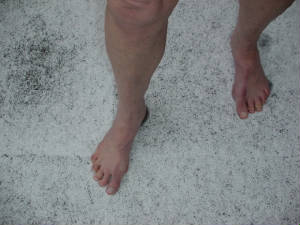To be a Pilgrim
The way of the pilgrim
may start gently but along the way there are sure to be challenges, physical and mental, which we must confront, surmount,
or get around.
Among
the following poses may well be ones which are familiar, some less so. There will be poses which challenge,
even intimidate, and others which will appear so easy that you may wonder why they have value. Take the
opportunity to deepen your awareness of each posture and exercise and its effect on you. In the end remember
that the inward pilgrimage is the more important journey.
Preparation
Before any undertaking take time to prepare yourself by centring and
earthing yourself.
Warming, and loosening up
Preparatory
Pranayama
Ujayii pranayama - yoga abdominal breathing
Viloma pranayama in Vajrasana - with retentions on inhalation.
(N.B. not for those with high blood pressure)
POSTURES (Asanas) and MOVEMENTS
1.
Surya namaskara - the salute to the sun, can also be seen as symbolising a journey through the day. There
are ups and downs and it is important to keep our eyes on where we are going.
2. Tadasana - the mountain pose. Like
looking at a map we can see the route we are to take as we take our consciousness up through the body.
3. Utkatasana
- the powerful pose. Strong legs, and steady balance are essential for the traveller.
4. Trikonasana
- the triangle. The symbol of great stability, and a powerful mind and body opening posture.
5. Parivrtta
trikonasana - the reverse triangle. Upside down and the wrong way round. A typical experience
for the pilgrim on a strange road.
6.
Parivrtta Parsvakonasana - the long stretch. Reach for the infinite. This is
one of the best opening, stretching and leg strengthening posturers.
7. Virabhadrasana - The standing foremost hero pose.
Virabhadra was created from the matted locks of Shiva, sometimes seen as his son. He was a fiercesome
warrior, steadfast, and a devoted guardian of Shiva and Parvati. Be valiant as a pilgrim.
8. Dandasana
- the staff. An essential piece of equipment for any pilgrim, and one of the essential accoutrements of
the yogi listed in Thirumoolar`s `Thirumandiram`.
9 Adho Mukha Svanasana - The backward facing dog.
In this posture the inward journey begins as we become aware of all its effects within the body.
10 Bhujangasana
- The cobra. Like the cobra feel your body rise effortlessly towards the sky and heaven.
11 Ustrasana
- The camel. A powerful front opening posture, but also one which exposes your vulnerability.
12 Marichyasana,
or Ardha Matsyendrasana - twisting postures to complete the freeing of the spine. Marichya was a son of Brahma, Matsyendranath
one of the 18 Siddhas of south India, both sages. On our journey it is good to look back and see the progress
made.
13
Inverted postures. Viparita karani, sarvangasana or sirsasana - Half or full shoulderstand, or headstand,
or any alternative. For many these are the ultimate challenge to self knowledge and acceptance..
Ending Pranayama
Viloma pranayam with retentions on
exhalation.
Relax in Savasana.
The Mountain meditation - trace your path from the base to the peak.
And what do you find?
Shanti
Derek Osborn
3 2002
0845 4589280
derekosborn@cwcom.net
